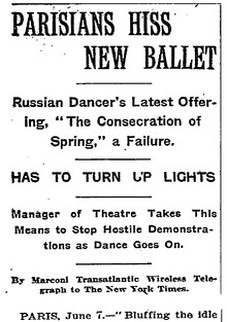
The first half of the concert was pretty much what you’d expect from Canada’s new-music orchestra: a world premiere (Paul Frehner’s Phantom Suns), and a “contemporary Canadian classic” (Claude Vivier’s Orion). But the second half of the program was given over to Igor Stravinsky’s Rite of Spring.
There were no riots at Koerner Hall last night – but Esprit’s choice to tackle the Rite was an eyebrow-raising decision. The piece turns 100 this year, making it surely one of the oldest works Esprit has ever performed. By music director Alex Pauk’s standards, it was a rare foray into “early music.”
For me, the highlight of the program was Frehner’s Phantom Suns. Judging by this piece, Frehener – a Montrealer who teaches at Western University, in London (Ontario) – is in many ways cut from the same cloth as Vivier. Like Vivier, he’s partial to a suspended sense of time, dense and complex textures (suggestive of electroacoustic music) and slip-sliding his way through lush harmonies. After warming up on Orion, Pauk and his band were in the right head-space for this work, and their performance was rich and nuanced.
What followed was a Rite of Spring unlike any rendition of Stravinsky’s most famous work I’ve ever heard. For the occasion, Pauk obtained permission from Boosey & Hawkes to perform an arrangement for reduced orchestra: a full sized Rite would simply be too big for Koerner Hall (and probably also too big for Esprit’s budget). This arrangement is often used by ballet companies, but is rarely heard in concert performances.
Thanks to the transparency of Esprit’s 63-player ensemble, it was possible to hear inner voices that are often submerged. But at the same time, the reduced score presented balance problems that weren’t always sorted out as well as they might have been. And moments of dramatic contrast – such as the shattering tam-tam led fortissimo in the “Spring Round Dances” – tended to lack the weight needed to achieve their full effect. (There’s no getting around the fact that size does sometimes matter.) Also, Pauk’s tempi often seemed confined to a safe “comfort zone.”
By taking on a warhorse like The Rite of Spring, Esprit invited comparison to the great orchestras of the world. Unfortunately, the resulting picture wasn’t especially flattering.
© Colin Eatock 2013
 RSS Feed
RSS Feed

